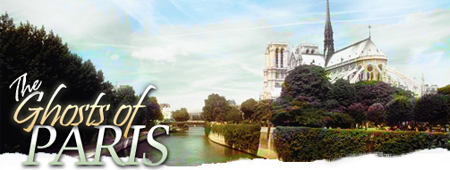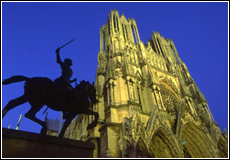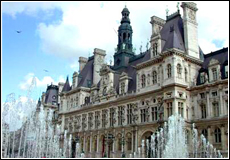|

Paris,
France: Legendary Parisians haunt
the City of Light
by
Susan McKee
You're
never alone in Paris. There are familiar
faces everywhere.
 Out
of the corner of your eye, you can
see Gene Kelly dancing in the streets.
And didn't you just catch a glimpse
of Amélie's face in that Montmartre
apartment window? Wasn't that Quasimodo
behind the gargoyle on one of Notre
Dame's bell towers? Cole Porter composed
here. Claude Monet painted here. Ernest
Hemingway wrote here. Lance Armstrong
rode to his sixth Tour de France victory
along the Champs-Élysées. Out
of the corner of your eye, you can
see Gene Kelly dancing in the streets.
And didn't you just catch a glimpse
of Amélie's face in that Montmartre
apartment window? Wasn't that Quasimodo
behind the gargoyle on one of Notre
Dame's bell towers? Cole Porter composed
here. Claude Monet painted here. Ernest
Hemingway wrote here. Lance Armstrong
rode to his sixth Tour de France victory
along the Champs-Élysées.
No
matter whether it's your first visit
or your 50th, Paris is at once familiar
and foreign. You've seen it-and heard
it-before. The City of Lights has
a sound track, too. It's Edith Piaf's
"La Vie en Rose," Charles
Aznavour's "Et Pourtant,"
and Jacques Brel's "Ne Me Quitte
Pas." Maurice Chevalier is forever
singing "Thank Heaven for Little
Girls" in Paris. And, if you
close your eyes, you can see Leslie
Caron and Gene Kelly dancing along
the banks of the Seine to the strains
of George Gershwin's "It's Very
Clear."
I
always begin my Parisian explorations
at Notre Dame, right at the kilomètre
zéro. This bronze disc, imbedded
in the pavement in front of the cathedral
made famous in Victor Hugo's classic
Hunchback of Notre Dame, marks the
point from which all distances from
Paris are measured. The cathedral
is the latest in a series of sanctuaries
built on the Ile de la Cité,
an island in the middle of the Seine
River. Here's where Paris got its
start when a Celtic tribe, the Parisii,
settled at the ancient trading crossroads.
Under
the landscaped mall in front of the
cathedral is a museum centered on
the island's ancient history. Among
the finds highlighted in the Crypte
Archéologique are remnants
of earlier churches, ancient streets,
and ruins of Roman villas. Notre Dame,
of course, isn't only a place where
the fictional Quasimodo rang the bells
for mass. Countless novelists, including
Sir Arthur Conan Doyle and Georges
Simenon, have spun fictional scenes
within its walls. This is where Napoleon
grabbed the crown from Pope Pius VII
and anointed himself as emperor of
France in 1804.
 It's
not easy to catch glimpses of Napoleon
in Paris, but his ghost clearly inhabits
the Hôtel des Invalides. Originally
built by Louis XIV in 1670 as a home
for old soldiers, it's now a massive
complex including the Musée
d'Armes (with its collection of military
history and artifacts). The Hôtel des Invalides is also the
final resting place of Napoleon. His
remains were interred under the golden
dome in 1861, 40 years after his death
in exile. The place also once served
as a royal armory. Many of the guns
used by the mob when it attacked the
Bastille on July 14, 1789, were taken
in a raid earlier that morning. It's
not easy to catch glimpses of Napoleon
in Paris, but his ghost clearly inhabits
the Hôtel des Invalides. Originally
built by Louis XIV in 1670 as a home
for old soldiers, it's now a massive
complex including the Musée
d'Armes (with its collection of military
history and artifacts). The Hôtel des Invalides is also the
final resting place of Napoleon. His
remains were interred under the golden
dome in 1861, 40 years after his death
in exile. The place also once served
as a royal armory. Many of the guns
used by the mob when it attacked the
Bastille on July 14, 1789, were taken
in a raid earlier that morning.
The
French Revolution still haunts the
city's shadows. Although the infamous
prison no longer exists (except for
an outline on the ground at the Place
de la Bastille) its ghosts-both the
fictional and the historical ones-remain
in Paris. I can hear echoes of Marie
Antoinette's fervent prayers as she
takes Holy Communion at the Cathedral
of Notre Dame before her imprisonment,
and I always think of Charles Dickens's
A Tale of Two Cities as I walk past
the Hôtel de Ville. Sydney Carton
is forever proclaiming, "It is
a far, far better thing that I do,
than I have ever done…"
as he mounts the steps to the guillotine.
Both
the Hôtel de Ville-Paris's city
hall-and the site of the Bastille
are on the city's Rive Droite, the
"right bank," as you follow
the Seine to the sea. Here, too, is
the Louvre, the single largest building
in Paris. I always seem to find myself
in the same place each visit, standing
in front of Leonardo da Vinci's "Mona
Lisa".
Across
the Seine is the Rive Gauche-the "left
bank." Sometimes I think I catch
a glimpse of Catherine Deneuve-which
might be true, because she lives here
in Saint-Germain-des-Prés.
But so did the 19th-century novelist
George Sand, and the Three Musketeers,
the heroes of novels by Alexandre
Dumas.
Every time I survey the multitude
of boulangeries, cafes, and bistros
in Paris, I think of Ernest Hemingway-one
of a generation of American expatriates
drawn to Paris between the two world
wars. "If you are lucky enough
to have lived in Paris as a young
man," he wrote, "then wherever
you go for the rest of your life,
it stays with you, for Paris is a
moveable feast."
Picking
up bread, cheese, and wine and enjoying
an impromptu picnic is a very Parisian
way to enjoy a leisurely lunch. (I
never forget to buy a half-dozen of
Marcel Proust's favorite madeleine
cookies for dessert).
Another American expatriot, poet Gertrude
Stein, had an apartment just around
the corner from the Luxembourg Gardens.
Others, such as F. Scott Fitzgerald, Cole Porter,
Sherwood Anderson, and Ezra Pound,
also lived nearby.
Many
of the cafes mentioned by the writers
in their diaries and novels still
attract tourists. Hemingway especially
liked La Closerie des Lilas on Montparnasse.
The hot spots shifted to Boulevard
St. Germain after World War II. Café
de Flore and Les Deux Magots (still
going strong) were favorite haunts
of Jean Paul Sartre, Simone de Beauvoir,
and James Baldwin.
Views
celebrated by the Impressionists are
everywhere in Paris. Henri de Toulouse-Lautrec
immortalized Montmartre with his paintings
of life in disreputable nightspots
such as the Moulin Rouge. Artists
Jean-Baptiste-Camille Corot, Vincent
Van Gogh, Toulouse-Lautrec, and Paul
Cézanne all painted the Moulin
de la Galette on rue Tholozé.
Montmartre is most familiar these
days, though, as Amélie's neighborhood.
On my last visit to Paris, I found
myself walking in the footsteps of
the heroine of the 2001 movie known
in French as Le Fabuleux Destin d'Amélie
Poulain. I sipped a cafe au lait at
the Café des Deux Moulins,
where the fictional Amélie
works as a waitress, and ended the
afternoon at Marché de la Butte,
purchasing (as she did) exactly three
hazelnuts and one fig.
Somehow,
in Paris it's easy to spot fictional
characters and ghosts. History is
all around me, and if I keep my eyes
wide open, I can see beyond the surface.
In Paris, I know I'm never alone.
If
You Go...
Notre
Dame
6 Parvis Notre-Dame
Place Jean-Paul II
75004 Paris
Ile
de la Cite
Les
Invalides and Musee d'Armes
Hotel
de Ville
Louvre
Windmills
of Paris
Le
Fabuleux Destin d'Amelie Poulain
|